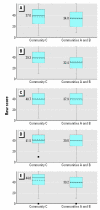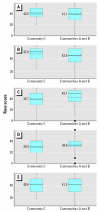Effect of community of residence on neurobehavioral development in infants and young children in a flower-growing region of Ecuador
- PMID: 17366832
- PMCID: PMC1797846
- DOI: 10.1289/ehp.9261
Effect of community of residence on neurobehavioral development in infants and young children in a flower-growing region of Ecuador
Abstract
Objective: In this study we compared neurobehavioral development in Ecuadoran children living in two communities with high potential for exposure to organophosphate (OP) and carbamate pesticides to that of children living in a community with low potential for exposure.
Methods: Women residing in the study communities who had a child 3-61 months of age completed a questionnaire about maternal and child health and sociodemographic characteristics. The Ages and Stages Questionnaire (ASQ) was administered to each child (n = 283). Growth measurements and a hemoglobin finger-prick blood test were obtained. We used multiple linear regressions to evaluate associations between community of residence and delayed development, adjusting for child health status and other characteristics of the home environment.
Results: Children 3-23 months of age who resided in high-exposure communities scored lower on gross motor (p = 0.002), fine motor (p = 0.06), and socioindividual (p-value = 0.02) skills, compared with children in the low-exposure community. The effect of residence in a high-exposure community on gross motor skill development was greater for stunted children compared with non-stunted children (p = < 0.001) in the same age group of 3-23 months. Children 24-61 months of age residing in the high-exposure communities scored significantly lower on gross motor skills compared with children of similar ages residing in the low-exposure community (p = 0.06).
Conclusions: Residence in communities with high potential for exposure to OP and carbamate pesticides was associated with poorer neurobehavioral development of the child even after controlling for major determinants of delayed development. Malnourished populations may be particularly vulnerable to neurobehavioral effects of pesticide exposure.
Figures




Similar articles
-
Neurobehavioral development in children with potential exposure to pesticides.Epidemiology. 2007 May;18(3):312-20. doi: 10.1097/01.ede.0000259983.55716.bb. Epidemiology. 2007. PMID: 17435439
-
Occupational exposure to pesticides during pregnancy and neurobehavioral development of infants and toddlers.Epidemiology. 2008 Nov;19(6):851-9. doi: 10.1097/EDE.0b013e318187cc5d. Epidemiology. 2008. PMID: 18813021
-
Sociodemographic and nutritional correlates of neurobehavioral development: a study of young children in a rural region of Ecuador.Rev Panam Salud Publica. 2007 May;21(5):292-300. doi: 10.1590/s1020-49892007000400004. Rev Panam Salud Publica. 2007. PMID: 17697482
-
Prenatal and childhood exposure to pesticides and neurobehavioral development: review of epidemiological studies.Int J Occup Med Environ Health. 2008;21(2):121-32. doi: 10.2478/v10001-008-0014-z. Int J Occup Med Environ Health. 2008. PMID: 18614459 Review.
-
Pesticides and child neurodevelopment.Curr Opin Pediatr. 2008 Apr;20(2):191-7. doi: 10.1097/MOP.0b013e3282f60a7d. Curr Opin Pediatr. 2008. PMID: 18332717 Review.
Cited by
-
Assessment of Maternal-Infant Interaction: Application of the Still Face Paradigm in a Rural Population of Working Women in Ecuador.Matern Child Health J. 2017 Mar;21(3):458-466. doi: 10.1007/s10995-016-2123-9. Matern Child Health J. 2017. PMID: 27443651
-
Effect of pesticide exposure on stunting incidence: a systematic review and meta-analysis.Clin Exp Pediatr. 2024 Oct;67(10):510-518. doi: 10.3345/cep.2023.01522. Epub 2024 Sep 24. Clin Exp Pediatr. 2024. PMID: 39314197 Free PMC article.
-
Adapting the Ages and Stages Questionnaire to Identify and Quantify Development Among Children With Evidence of Zika Infection.Infants Young Child. 2020 Jun;33(2):95-107. doi: 10.1097/iyc.0000000000000161. Infants Young Child. 2020. PMID: 33132516 Free PMC article.
-
An educational intervention on the risk perception of pesticides exposure and organophosphate metabolites urinary concentrations in rural school children in Maule Region, Chile.Environ Res. 2019 Sep;176:108554. doi: 10.1016/j.envres.2019.108554. Epub 2019 Jun 24. Environ Res. 2019. PMID: 31288198 Free PMC article.
-
The Study of Environmental Exposure of Mothers and Infants Impacted by Large-Scale Agriculture (SEMILLA): Description of the Aims and Methods of a Community-Based Birth Cohort Study.Children (Basel). 2024 Aug 27;11(9):1045. doi: 10.3390/children11091045. Children (Basel). 2024. PMID: 39334577 Free PMC article.
References
-
- Banks EC, Ferretti LE, Shucard DW. Effects of low level lead exposure on cognitive function in children: a review of behavioral, neuropsychological and biological evidence. Neurotoxicology. 1997;18:237–281. - PubMed
-
- Benefice E, Fouere T, Malina RM, Beunen G. Anthropometric and motor characteristics of Senegalese children with different nutritional histories. Child Care Health Devel. 1996;22:151–165. - PubMed
-
- Breilh J, Campana A, Hidalgo F, Sanchez D, Larrea ML, Felicita O, et al.
-
- Breslau N, Chilcoat H, DelDotto J, Andreski P, Brown G. Low birth weight and neurocognitive status at six years of age. Biol Psychiatry. 1996;40:389–397. - PubMed
-
- Breslau N, Paneth NS, Lucia VC. The lingering academic deficits of low birth weight children. Pediatrics. 2004;114:1035–1040. - PubMed
Publication types
MeSH terms
Substances
Grants and funding
LinkOut - more resources
Full Text Sources
Medical
Miscellaneous

